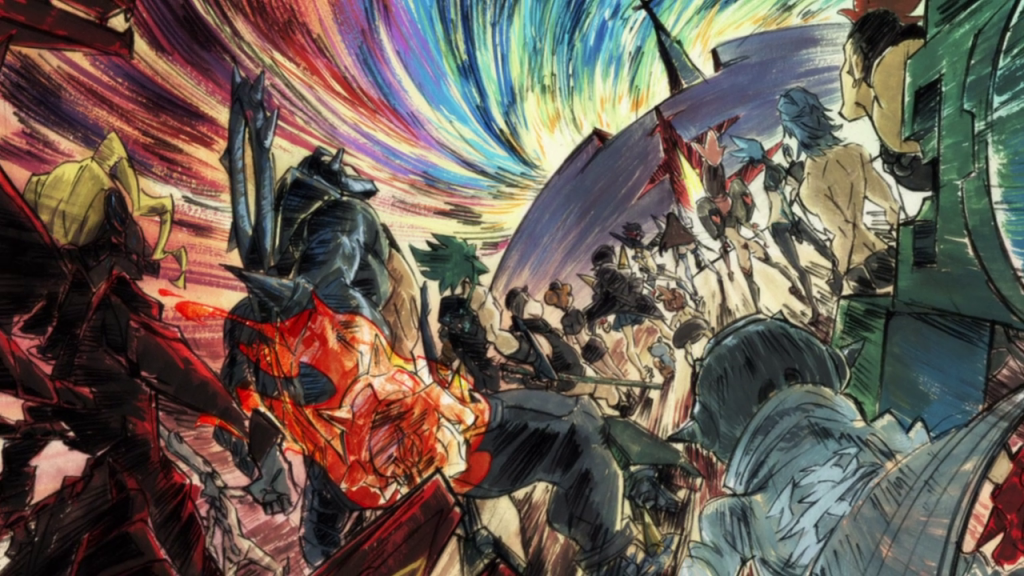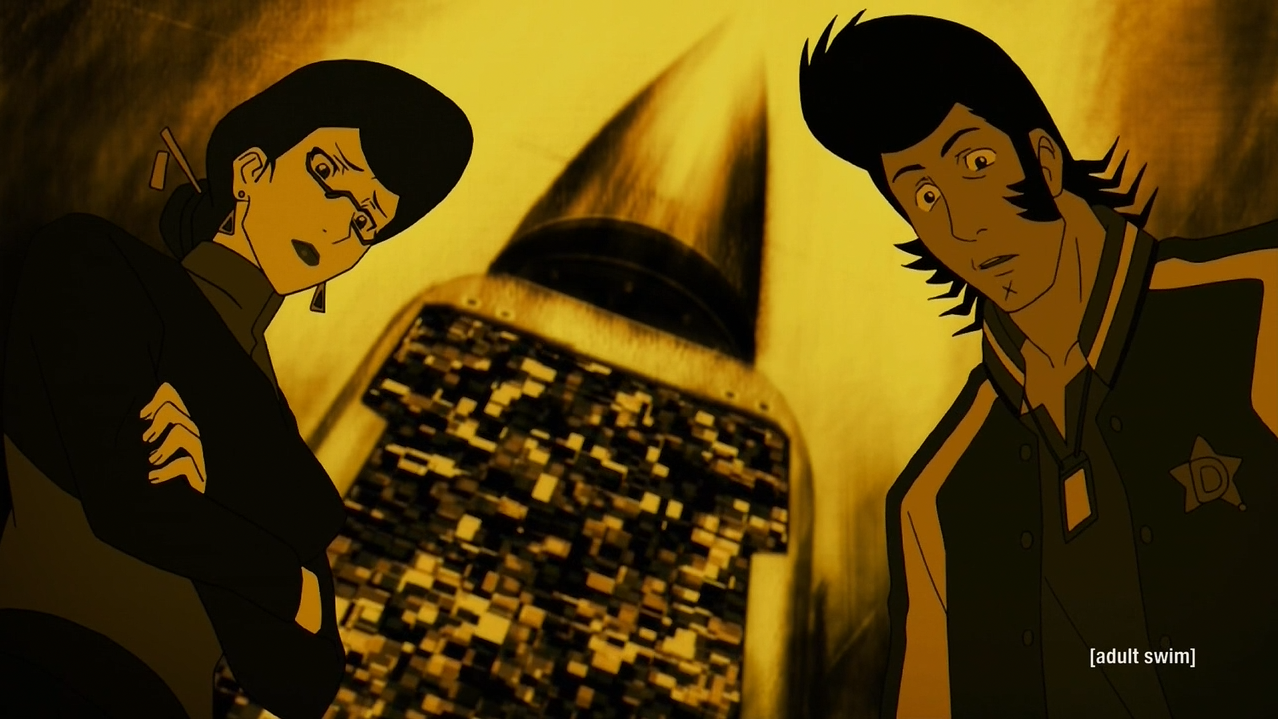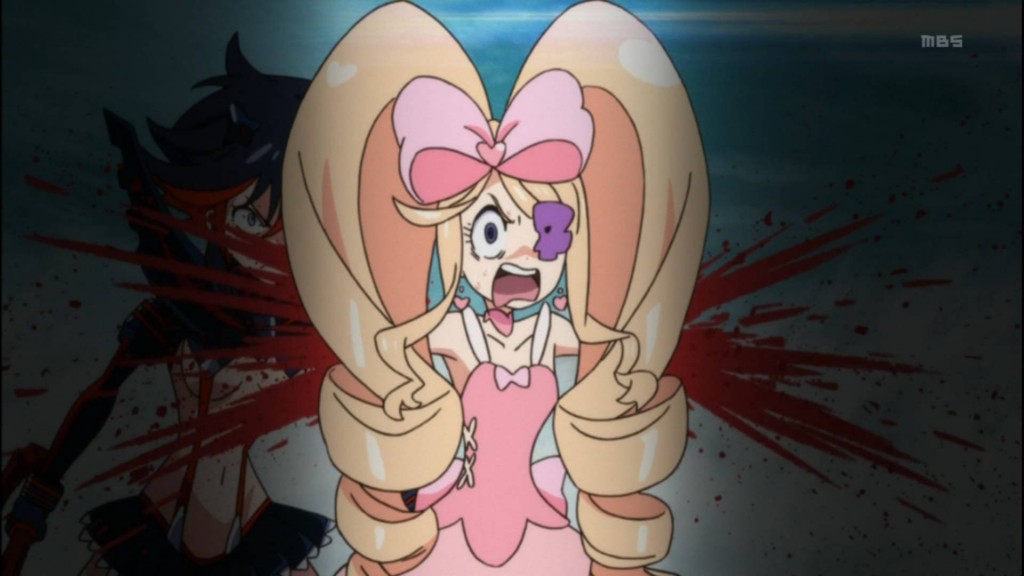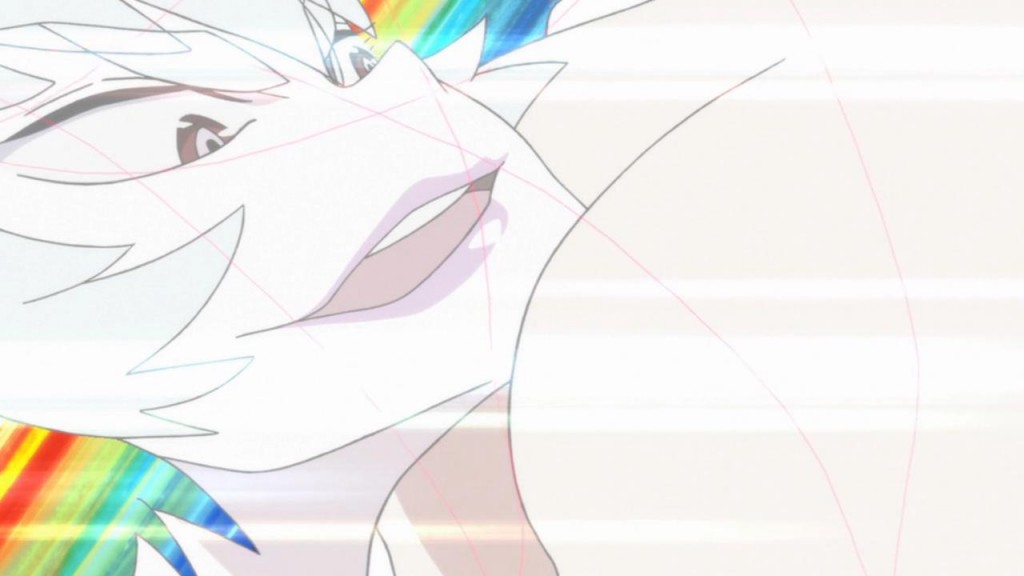Hey guys, I’m back with my Cartoon Cartoon retrospectives! It’s been a while, but I’m glad to try my hand at these again, and I’ll attempt to at least make it through the first season of each of these shows. To save my sanity, I won’t try to post each article up around Friday, although I would like to make these a weekly series after all.
Next time, I’d like to add some more comments before I go into these look throughs, but for now, I just want to start talking about my plate today.
Dexter’s Laboratory:
“Babysitter Blues”

Dexter and Dee Dee’s parents are going out for the night, which means the kids are having a babysitter take over them.
What’s the catch? Dexter’s got a girlfriend! Dexter’s got a girlfriend! Dexter’s got a gi-
Yes, like Alvy Singer before him, the boy genius skipped over his latency period, and has the hots for his teenaged babysitter. See, even braniacs can fall in love. The episode starts off with Dexter reorganizing the house into a presentable fashion for his babysitter, even going as far as to shoo off the family’s on-again,/off-again pet dog.
Except, it seems as if Lisa the baby sitter has a boyfriend of her own, and apparently it’s Fuzzy Lumpkins, to boot! (okay not really, but isn’t it funny to hear a reference to the character before Powerpuff was bought as a show? Don’t forget, he was in the original What-A-Cartoon pilot).
Dexter can’t bear to see his true love taken away from him, so he uses a voice modulator to confuse both Lisa and her boyfriend, by breaking the couple up for them. A sick twist, but one that works for Dexter. He comes to Lisa’s comfort while she’s still on pain, which is when she says one simple line that turns the short over into gold from there. I won’t spoil it, but to give you an idea, there’s payback, a great usage for Dee Dee, and a typical, albeit necessary, quick gag ending.
The short started out as moderately funny, with a decent gag shared here or there alongside a one-note character and a so-so running joke with Dee Dee, but really turned into a laugh riot at the end. Peaking too late on is a bit of a problem, yes, but depending on how great the pay off is, the wait is typically worth it, especially if you view the episode as build-up towards a particularly strong gag. The episode is cute, although it’s not up there with the best.
“Valhallen’s Room”

We’re only two segments into the Justice Friends, bur already, it’s proven to be a much stronger companion series than Monkey. Personally, I liken this phenomenon to the fact that Major Glory, Valhallen, and Kronk have stronger, more fleshed-out personalities than Monkey and his agents do, which tended to fall into tiresome clichés. The fact that there are usually solid jokes in the Justice Friends’ cartoons is another advantage.
Take this one, for example. The short starts off with Major Glory making an all-American breakfast for his roommates/compadres (and keep an eye on how the close-up on Glory’s buffet compares to what we see throughout the rest of the scene- Major Over-Exaggeration isn’t as appealing of a super hero name, but it sure seems appropriate here), but the entire breakfast is ruined because Valhallen hasn’t awaken yet. So until the Norse god of rock n’ roll gets his golden locks out of bed, Kronk can’t get a pancake for himself. That’s one thing, but after hearing ominous sounds coming from Valhallen’s room, the two heroes become worrisome.
Hungry for some justice, as well as breakfast, Glory and Kronk make their way into Valhallen’s room, giant as it is (he pays extra, while Kronk’s teddy doesn’t pay at all). After finding a weakened Valhallen on his bed, it is discovered that he lost his magic axe. This Flying V-shaped weapon is Valhallen’s equivalent to Mjonir, meaning that when enough time is removed, his power will decrease drastically. Being the good (hungry) friends that they are, Glory and Kronk attempt to find the rocking revolver of righteousness.
The rest of the episode delves into quick sight gags, as Glory and Kronk attempt to find Valhallen’s weapon. In other words, what you’d basically expect from the show, but not that there’s anything inherently wrong with that, as long as it works. For “Valhallen’s Room”, while this doesn’t turn out to be a masterpiece of the animated form like some later Dexter stories will become, it’s a fine follow-up for this series of shorts.
Already the voice cast has their characters down. Rob Paulson’s bravado for Major Glory is near perfection, as he pulls off an intense delivery for each line with relish, while Tom Kenny was continuing to prove his chops in the field as he tackles two different angles for Valhallen this episode. And let us not forget Frank Welker’s wonderful Hulk impression for Kronk, as he continues to make most every line gold, while keeping a nice, sentimental side in tone for the character. It’s a fantastic balance with tight chemistry that makes the characters pop here. Without the talent behind the recording studio, the Justice Friends wouldn’t have been as entertaining as they are, and while I await getting into some of the best stories for Dexter and Dee Dee, I do wish that we had more time with Major Glory and co in their own shorts as well.
“Dream Machine”

What makes Dexter tick? What are his weaknesses? Is there more to the character than just his resentment over his sister’s dominating personality and his love of science?
We do find out some of these over the course of the show, like in this story. If there’s one thing to take away from fiction, it’s that dreams are windows into the psyche of a character. Usually, they come as weird as you can imagine, if not significantly weirder, but in some instances, all you really need to show is a reminder of how reality functions to crack into the mind of the dreamer.
Although it is questionable that Dee Dee is able to ace her way through a big test given by Albert Einstein himself like it’s nothing, but somehow Dexter thinks 2 + 2 equals Mount Rushmore. But in this opening sequence, it becomes apparent that Dexter’s intellect, usually a high point in his life, isn’t always something he’s secure of. He may be smart enough to build a laboratory all by himself, but what does it mean?
I dunno, but Dexter has been having 3 straight weeks of nightmares like this, and he won’t take that lying down anymore. He grabs a barely-conscious Dee Dee to help him break this streak, and give Dexter a nice dream or two instead.
Using the concept that we control our own dreams to his advantage, Dexter sucks up all of the intellect available in the world to make him a walking super computer of sorts, but in traditional fashion, things aren’t so easy for our boy genius. To completely access his goal, Dexter must find the grandfather of all knowledge, whose being surprises him.
The story takes a twist for the weirder, as it uses the idea that Dexter’s sneaking into all-knowing knowledge is cheating, which shouldn’t be tolerated. This is a successful ending to an otherwise decent enough short. For better and for worse, this episode curved past the traditional beliefs of television that a character’s dream should walk us with and into their mindset, as Dexter becomes in control of how his sleeping patterns occur, only to lose them as he delves into his selfishness. For a show that isn’t afraid to play with its logic like Dexter’s Lab is, it’s a fascinating take, although I’d argue that it isn’t the funniest story that the series is capable of. Still, a good final short for a solid episode to signal my return to this show I so greatly admire.
Johnny Bravo:
“Beach Blanket Bravo”
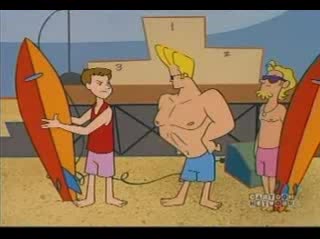
It seems like another beach day for Johnny, as he sets up his area, appropriates his image for the place, and looks for the right girl to make his move on. He catches a mighty fine senorita, and he tries to get her to do the Monkey with him. Either taking this as an invitation for friendship or kindly passing him off, the lady gets the rest of the beach goers to (poorly) do the Monkey with them.
It does sound like a basic Johnny story, but the short’s intent becomes clear when we delve into the relationship turmoil between young surfer Andy (voiced, inexplicably, by Rick Springfield) and his steady, Franny. Andy is very much a product of the 50’s/early 60’s and believes that a woman should be stuck behind a kitchen, which in today’s society is obvious bs. In her hopes to cheese him off, Franny finds the first decently attractive guy she can find as a date to tonight’s weeny roast. Three guesses as to whom she decides on.
“Beach Blanket Bravo” is a throwback of sorts of American International’s surf movies of the mid sixties, usually starring Frankie Avalon and the recently deceased Annette Funicello. These movies were hokey products of their time, which of course makes them ripe for parody. Funicello’s very own beloved Disney had a smart spoof of the surfer lifestyle in 1965’s That Darn Cat!, made shortly after the apex of the subgenre’s presence, while artists keen on the nostalgic have occasionally brought these back to life since, and if there’s one thing the early Johnny Bravo episodes are good at, it’s bring back to life the remnants of slightly forgotten sects of the pop culture landscape.
This is a clever cartoon, as someone familiar with these movies despite not being a connoisseur, exactly, but it does bring up a problem with such stories like this- Johnny doesn’t really work as a straight man. At least, not always, and here’s an episode where he is meant to be very much modern as opposed to the retro chauvinist hipster that Andy is.
The problem with Johnny as a straight man is that he’s not exactly a likable guy. Johnny’s a dumbass and a bit of a chauvinist himself, so the series works great when the joke is on him, but when he’s opposed to funky side characters like the Avalon-meets-Archie Andy or the talking shark with a mask on (a highlight I wasn’t sure how to introduce here, as he does have some of the best gags in the short), there isn’t much to the character or, as a result, the cartoon.
Thankfully this is saved with some references to dated lingo that I doubt even your parents would use accordingly, as Johnny’s blank replies to Andy and Franny’s suggestions make him sound genuinely confused. It’s also great when Johnny threatens Andy to a serious butt kicking, only to get a gasp from the crowd.
Also entertaining is the surf contest Johnny and Andy go on, combining solid animation for the two characters over footage of actual waves. There’s even a bit of green screen to keep an eye out for. The only way the short could get more authentic to this style of film is to end with a cheesy song number, and…
My criticism rings true in that while the concept is cute and does make for some great jokes. The idea of making Johnny a relatable straight man is questionable. This morphs into a good cartoon at the end o the day, but I think that the use of Johnny’s lack of intellect would make it an even better one, as it would be the case if this was done later in the show’s run.
“The Day the Earth Didn’t Move Around Very Much”

Here we come to a MacFarlane written/Hartman directed tale, in which Johnny is require to recount his restricted day in which the episode title comes to life.
This is a wacky little ditty in which a jet crashes through a telephone wire, cutting out the power in the Bravo household and making a noise. After seeing that the clock on Johnny’s VCR isn’t working (hello, 1997!), Johnny comes to the rational conclusion that time is working for everyone but him. I guess that Twilight Zone marathon got to him, but I’m sure we won’t see any other results from that in later episodes.
In typical Johnny fashion, he sticks around for only a couple of seconds at each instant before he comes to the conclusion that time has stopped, like when the water won’t start in his shower, or if traffic is frozen.
But where the jerk side of Johnny comes from is why he is in court- he takes this newfound concept of frozen time to go and become a common thief in plain view. As each of incidents where time seems frozen for the rest of Aaron City becomes sillier and sillier, Johnny continues going on with his belief and becomes a nuisance. Johnny’s slow day even ends with him passing out to an infamous freeze-frame commercial shot from the Dukes of Hazzard.
There’s a bit of a surprise ending for Johnny, which ends this mostly one-note cartoon in a bit of a twist We’ve previously learned that Johnny is a jackass, so it isn’t too much of a surprise to see him steal his way through the day like it’s nothing. Sadly, when you get the core concept down, there isn’t too much to it, and while the gags do work if you keep your suspension of disbelief, the show has already proven that it can be smarter, so it is disappointing to see it result in a mostly obvious route. Still, I can’t fault this one too much, as it makes me laugh a good deal. Although who the hell plays charades in a restaurant kitchen?
“The Aisle of Mixed-Up Toys”

The previous short had Johnny briefly catch an old Dukes of Hazzard episode, wile this one starts off a little more timely and has him catch a little parody of Speed on the TV, right down to a half-decent Keanu impression. What does this have to do with the rest of the episode? Well, there is a hit at an explosion for Johnny to deal with later on.
Here Johnny is just chilling on the TV, as he often does between hitting on women (for someone as built as he is, does he ever work out?), when a cute little girl that isn’t Little Suzy rings the door and asks for him to donate toys for charity. In this week’s installment, Johnny is too old to play with toys, so he promptly turns her down, until her older sister chastises Johnny for being so cruel. Not being one to turn down a pretty lady, he offers to go to the toy store for the girls’ charity, in ten minutes or less.
With only a buck in his pocket, Johnny needs to scamper and pick a couple of nice choices in the discount center at the local toy store. A year before Small Soldiers though, Johnny finds himself talking to his newfound endeavors. He finds an out-of-fashion Ken doll with a Phil Hartman-esq vocal crack, a (mostly) limbless howling commando, and a sarcastic automatic bomb-meets-Rubik’s cube thingy.
Three nice little toys would make for a nice addition to the charity drive, but if Johnny just walked out with these figures with no conflict, there wouldn’t be much to this story. The army figure won’t leave the store without his arms and leg, which means that Johnny has to face Raggedy Angelo, the freakish Quasimodo-like figure who removed the poor body features.
This results in a toy aisle fight that is a strange mix between the march of the wooden soldiers from Babes in Toyland (well, there goes my Annette Funicello reference allowance for the week) and the opening action sequence from Toy Story 3. Okay, maybe it’s not that epic, but like the rest of the episode, it’s cute.
Cute, yet unremarkable. Not to say that it’s bad, although the toys don’t make much of an impression, nor is the writing at the show’s best. It’s just mostly there, and fits with the show’s tiresome “wacky sidekick adventure” formula, one that will mostly be dropped soon.
Fun fact: in later prints for repeats, Raggedy Angelo’s “what a spazz” line replaces t he “s” word with “turkey” instead. Since when was spazz considered a bad word is beyond me, but the DVD restores the original line as spoken.
The Powerpuff Girls:
“Paste Makes Waste”

This episode starts off with a basic Pokey Oaks roll call, with the lovely Ms. Keane calling out for her kindergarten students one at a time. Standard practice, yes, and be sure to keep an ear out for some of the students’ names. Like Elmer S. Glue, the unfortunately-christened kid whose passion is eating yucky paste.
Of course, Mitch Mitchelson, the class bully, mocks Elmer’s admittedly unsanitary habit, which causes a group taunting of the kid from others who probably shouldn’t be mocking anyone else. Blossom and Bubbles wisely stay out of the commotion, but Buttercup, who has never been afraid to step up, goes as far as to throw paste at poor little Elmer. To make things worse, Buttercup won’t even apologize for being so mean.
Ms. Keane gives Elmer a little speech on even though the kids were unfairly cruel to him, he shouldn’t eat paste to begin with. But like most kids a nice little talk with an authority figure isn’t usually going to stop you from doing bad.
Which of course has its negative effects in Townsville. After a series of freak accidents around the city causes a nuclear waste to make its way into Elmer’s paste, and a quick taste gives the kid the powers of a Stay Puft-esq paste monster, giving Elmer the perfect chance to exact his vengeance on the students. This results in the girls having to take on Elmer before he destroys Townsville.
Imagine how differently this would have turned out if Buttercup apologized to Elmer before he became a paste monster. Obviously he’d still be a monstrosity of sorts, but Elmer’s rampage wouldn’t have been so intense if Buttercup owned up sooner. This is a creative enough idea for a short, but light on jokes, like some of the earlier episodes of the show. That isn’t too much of a bad thing though, since even despite not having a plethora of clever jokes, the show’s appeal for audiences came early thanks to an early strong grasp on the characters and their peculiar adventures fighting crime. The pacing that made the show fresh for kids and adults even early on is present here to make it a good episode to watch.
“Ice Sore”
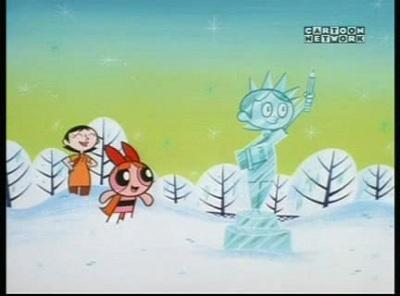
Now this is a little more like it. Townsville is suffering from a dangerously hot day, and the girls are feeling the burn in their house, eating hot soup for an inexplicable reason.
All is resolved when Blossom decides to breath into her hot soup though, and we discover something new- ice breath! And yes, this is new to the girls, too. And something only she is capable of.
After a suggestion from Bubbles that Blossom tries out her new power so they skate on the kitchen floor a la Tom & Jerry (bonus points if you can name which short this happens in), the girls are having a cool little time on this scorching day, Eventually, the professor steps in and almost slips on the ice when he discovers Blossom’s new power, and tells her to save it for the time being, emergencies aside.
A hot, miserable day at school gives Blossom just the need for emergencies to try out her new ice breath. Even the usually loving Ms. Keane becomes a boiling mess under this massive heat wave, which eventually causes Blossom to make it nice and cool over in the schoolhouse. This makes it nice for the class, but Blossom’s sisters get rightfully jealous when her new power gives her special attention today.
But even barring that, Blossom decides to permanently retie her ice breath after it gets in the way of the girls from saving the day. But it shouldn’t come as a surprise that Blossom rectifies her decision by the end of the episode for a very particular reason, resulting in an ending that’s both cooler than cool and smoking hot at the same time.
I think the reason that the last episode wasn’t too funny is due to a lack of supporting characters beyond Ms. Keane and some of the students. While the girls and their teacher are fine, earlier episodes relied on some of the other residents of Townsville for their strongest laughs, particularly the Mayor and his doting miss Bellum. He’s here and has a couple of good lines during the climax, but even without him, the episode isn’t lacking from any during the rest of the episode. “Ice Sore” is the stronger of the two segments, but it’s a solid half hour regardless. I’m just glad to be back with the girls.
Ed, Edd n’ Eddy:
“Fool on the Ed”

Oh hey, what an appropriate choice to bring this series back on, the April Fools Day episode! I haven’t seen this one in a while, so let me try to get through it again.
Eddy’s running around with his tongue in the air, as per usual, heading over to Ed’s house. This seemingly normal day become subsided when Ed’s just about to get his prank out to Eddy… except Eddy is five steps ahead of Ed, pulling off a couple on the poor sap.
The buddies then head over to Double D’s house, and the same happens. So you can probably guess that Eddy is the king of pranks, and his goal this day is to skip any scams and instead give everyone hell.
All goes well until a trip to Rolf’s, however, when before Eddy can even lift a finger, the son of a shepherd gets hit by a crazy plot. It turns out that someone has beaten Eddy to the punch, a certain “Prank Master”, and now it’s a battle of wits for the rest of the episode. Yes, eddy has some form of wit in him.
No amount of wit can do much good for Eddy, though, as the Prank Master scores his vengeance over the rest of the Cul-De-Sac before the Eds can do anything. This makes for a fun montage of seeing the other kids get trapped before we get to the conclusion of who the Prank Master is. And let’s just say that the Eds, Eddy in particular, are not happy.
Cue Eddy’s infamous stink bomb. If this beauty (invented by Eddy’s brother) is brought to life, imagine how many noses would become paralyzed. And it works, with a price. Be careful with what you wish for, though.
Part of me thinks that this would have worked better as a double-length episode, where the Prank Master is built up as a big mystery before the inevitable reveal, but that might have been TOO much. This episode works just fine the way it’s set, though. It’s hard to imagine an episode of the show without some great lines, and it does succeed there. This also excels at expanding on Eddy’s showmanship without relying on a basic scam. Here he’s being outshined at his game, and he’s out for vengeance. Eddy’s a tough cookie to crack, but he’s very much about his pride. While all of this rings true, though, there are better episodes this season, and far more highlights to look forward to.
“A Boy and His Ed”
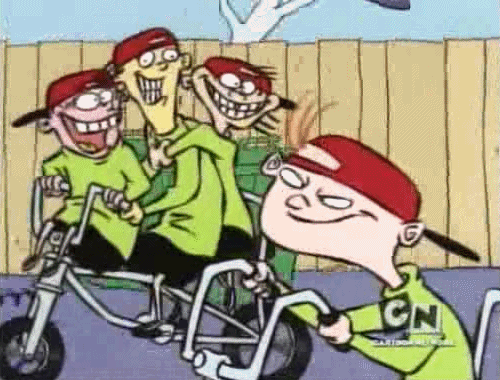
But if you want to see one of the boy’s scams again, check out this beauty. The Eds dug a hole in the middle of an alley side, and fill it up with water from Ed’s house to make a moat that kids have to pay for to access. Talk about a douche move, but damn if it isn’t legit.
The first kid to make it to the moat is Kevin, who’s willing to give the guys something. Problem is, Eddy won’t hear anything about it, while Kevin won’t pay up and walks off. As a result, Eddy and his buds miss out on free jawbreakers, since Kevin’s dad works for a jawbreaker factory now and gave his son a bunch of freebies, on account of there being a garage FULL of the things. Now it’s clear what the guys have to do.
Taking a cue from Ted Mosby’s lessons to a young Barney Stinson about all there is to Robin*. But as we’ll learn later, Ed and Eddy just aren’t good students, and they don’t end up taking Double D’s lessons on Kevin to heart, whatever they were. Instead, they just screw around for a good minute or two, resulting in some great gags.
Although can we just take a moment to appreciate the creative mind of this show, like when Ed decides to make a spitball out of a chewed-up book, and destroys his straw as a resort. Genius!
From here on in, the Eds try to suck up to Kevin in whatever way they can. Now, if Kevin was a celebrity, some of this material might be considered something called “stalking”, like having the Eds dress up just like Kev, or throwing a cheer outside of his house, but I digress. Hell, they even end up in Kevin’s bathtub by the end!
Still, this does result in a very funny little episode. Kevin’s rightfully annoyed with the Ed boys here, who try too hard to obtain their goal. This makes for one of the first times that the Eds deserve what inevitably comes to them, and that’s one thing that helps to define the show. The Eds are likable people, but they’re also rough characters that often deserve some sort of comeuppance (yes, Ed and Double D too). I really do love these three characters, but part of the fun of the show is seeing what direction the characters go through this week, a point which becomes further explored as the series continues to go along.
*yes, I know that this How I Met Your Mother episode was made about a decade after this Ed, Edd n’ Eddy one, but hey, I’m still grieving, y’no.
Overall:
What a nice week to come back to! Tons of good episodes all around, but if you really want me to choose a favorite, I think I’ll side with “Valhallen’s Room”. Good stuff. As you can tell, I’m done with picking out episode highlights, as I want to just stick to my own pace. But I promise that I’ll try to work on the next one soon, and will hopefully get through these first seasons before the summer starts. Until then, I hope you enjoy!












